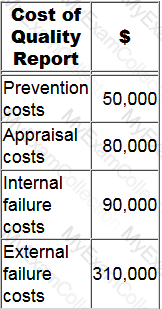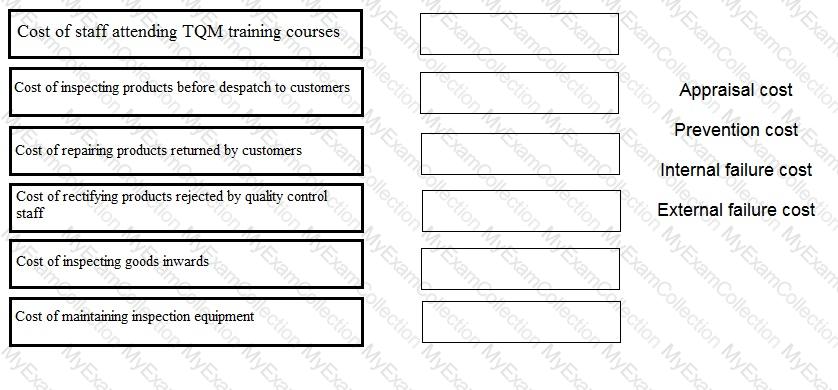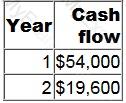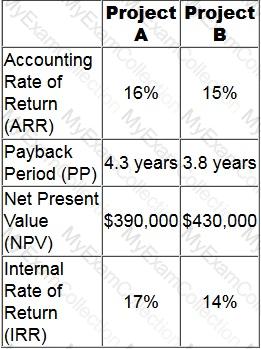One aspect of life cycle costing is the recognition of the fact that during the design or development stage a large proportion of many products' life cycle costs are:
An organization wishes to make its investment decisions on the basis of more than simply a financial appraisal. Which of the following will assist it to take into account both qualitative and quantitative factors?
Kaizen costing is being used by an organization to gradually reduce the unit cost of one of its products in order to achieve a 20% mark up on the product's cost.
The selling price of the product must be $72 per unit and this selling price has been maintained for two years.
Two years ago the product's cost was $3 per unit more than its selling price. Kaizen costing has achieved an 8% reduction from the previous period's unit cost in each of the past two years. The organization expects to continue to achieve the same rate of cost reduction next year.
Which of the following statements provides an accurate analysis of the extent to which Kaizen costing has been successful in achieving the required unit cost for the product?
LL produces an item, the Z, for which the demand curve is estimated to be:
P = 10 - 0.0001Q
where, P is the unit price in $ and Q is the annual sales volume in units;
Marginal revenue (MR) = 10 - 0.0002Q
The variable cost of producing the Z is $2 per unit. The annual fixed costs of production are $110,000.
What is the profit maximizing output level?
Which of the following is a key objective when agreeing a basis for setting transfer prices?
An electronics company sells a range of tablet computers. Tablet computers come complete with an operating system that is regarded as the market leader. The company aims to launch a new version of its hardware every eighteen months and a major update to its software every three years. The latest version of the tablet computer is always sold at a higher price, but the older version that has been replaced is then sold for a time at a discounted price.
Which pricing model does this company appear to be using?
In accordance with a just-in-time (JIT) philosophy, which of the following is regarded as a value added activity?
A division of company XYZ has reported an operating profit of $350,000 and its residual income (RI) has been calculated as $60,000. The company's cost of capital is 12%.
The division's return on investment (ROI) is:
An organization wants to increase the use value that customers place on one of its products - a laptop computer.
Which of the following actions, taken to increase the value to the customer, would increase the product's use value?
Select ALL that apply.
The following cost of quality report has been prepared for the latest period.

What is the difference between the cost of conformance and the cost of non-conformance?
A firm of accountants uses an activity-based costing system. The firm's costing system permits staff to indicate specific tasks undertaken for clients, such as requesting missing information. The amount charged for a request for missing information is based on the following analysis.
Each request takes an average of 15 minutes of professional staff time. Professional staff are charged out at $100 per hour.
Administrators then process the information request and prepare a standard letter. The average time administration staff spend on each information request is 20 minutes. The cost of administration staff at the firm is $75,600 per year. Administration staff work for a total of 6,000 hours per year. The cost of printing and posting a letter is $1.
Calculate the cost of an information request.
Give your answer to 2 decimal places.
Place the correct quality cost classification against each cost described below.

Which of the following activities are included within activity based management (ABM)?
1. Cost reduction
2. Product design decisions
3. Variance analysis
4. Operational control
5. Performance evaluation
An organization is comprised of two divisions. One of the divisions manufactures a product that it sells both to an imperfect external market and to the other division.
The organization wishes to establish the most suitable basis for the transfer price for this product and is considering either a negotiated transfer price or a market-based transfer price.
Which of the following statements is correct?
A project requires an initial investment of $50,000. It will generate positive cash flows for two years as follows.

The cost of capital is 12% per year.
What is the equivalent annual net present value of the project?
Give your answer to the nearest $10.
Which of the following is the ideal basis to use for a transfer price when there is a perfect external market?
A new product is being manufactured for the first time. The first unit required 600 minutes of labor to manufacture. It is expected that there will be a 90% learning curve for the first 20 units.
The learning index for a 90% learning curve is - 0.152.
Calculate the expected labor time to manufacture the 10th unit.
Your answer should be given to the nearest whole minute.
Juan is looking to invest in the mining industry. He has narrowed his options down to two rival companies, both with sales of £200m. Company A has an EBIT of £10m whereas Company B has an EBIT of £14m.
This would suggest that Company B is the better investment but Juan is suspicious that Company B has more financial backing than Company A.
Which ratios will tell him which company will use his investment the best?
How does beyond budgeting NOT help to resolve the weaknesses of traditional budgeting? Select ALL that apply.
A company is considering two mutually exclusive projects, an analysis of which is given below:

The company's cost of capital is 12%.
Assuming an objective of maximising shareholders' wealth, which project would be recommmended?
Place each performance measure against the correct perspective of the Balanced Scorecard for a company that operates a chain of hotels.

Which THREE of the following are advantages of changing from a 'top-down' to a 'bottom-up' (participative) style of budgeting?
Product WB currently sells for $13 per unit. Annual demand at that price is 20,000 units. If the price increases to $15, the annual demand falls by 500 units.
What is the formula for the demand curve?
A company is investing $200,000 in a project which will generate a cash flow of $60,000 each year for five years starting immediately. The company's cost of capital is 7%.
The net present value of the investment to the nearest $100 is $
Company X is considering the launch of a new product. In order to compete in the market the selling price must be $100 per unit. Company X aims to achieve a sales margin of 25 per cent.
Direct materials cost is $75 for each unit. It takes 15 minutes for workers to assemble each unit. Workers are paid $16 per hour. 5 per cent of paid time is idle. Overheads are absorbed at $6.50 per unit.
What is the value of any cost gap between the forecast total cost and the target cost?
K Supermarket spends $80,000 per year on checking and processing receipts of inventory. Annual warehouse costs are a further $70,000 per year. These costs are currently treated as fixed overheads in the company's costing system.
As an experiment, the company is preparing a direct profitability analysis of a small range of products, including fresh grapes.
K Supermarket receives a total of 3,600 deliveries every year. 20% of these deliveries are of perishable goods such as grapes. It takes twice as long to process a delivery of perishable goods compared to a normal delivery because perishable goods have to be checked more carefully.
Half of the warehouse costs are for the chilled store that is used to store perishable goods. At any time, the chilled store has 800 kilos of perishable goods in stock.
K Supermarket receives 150 deliveries of grapes every year. Each delivery is for 100 kilos of grapes. The grapes spend an average of two days in the chilled store before they are sold.
Calculate the total cost per kilo of checking, processing and storing grapes that should be taken into account in determining the profitability of grapes.
Give your answer to the nearest whole cent.



